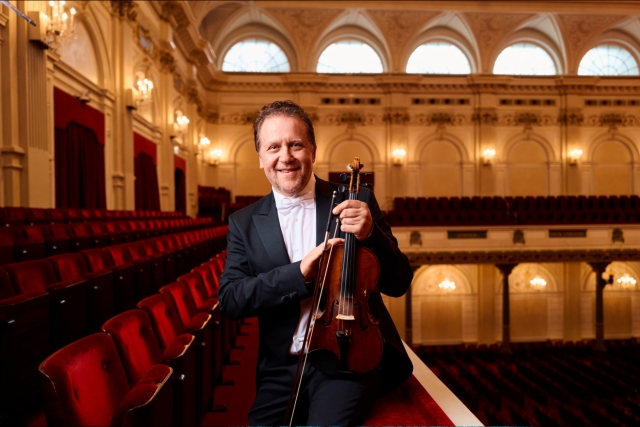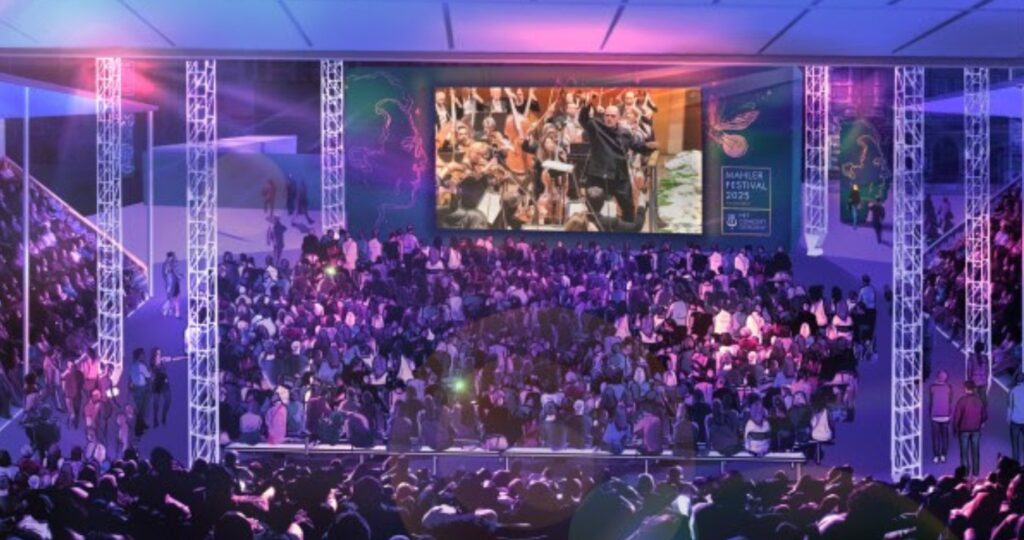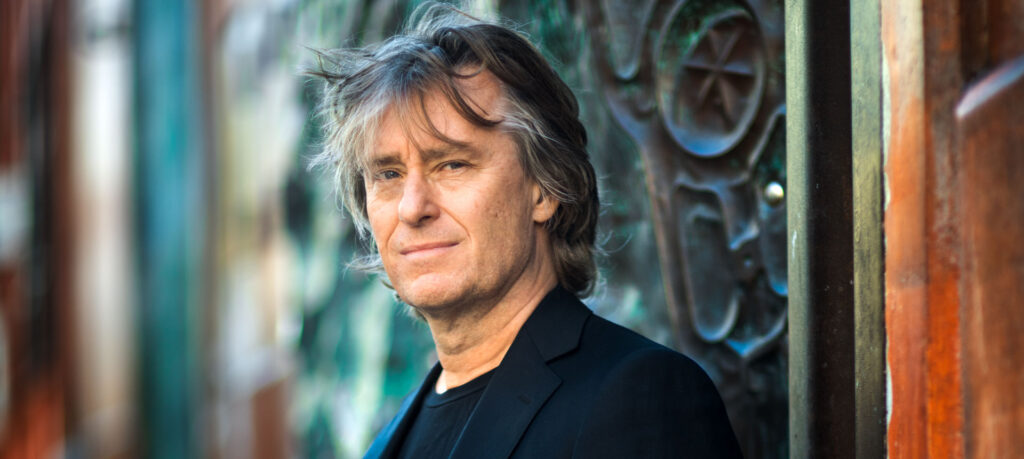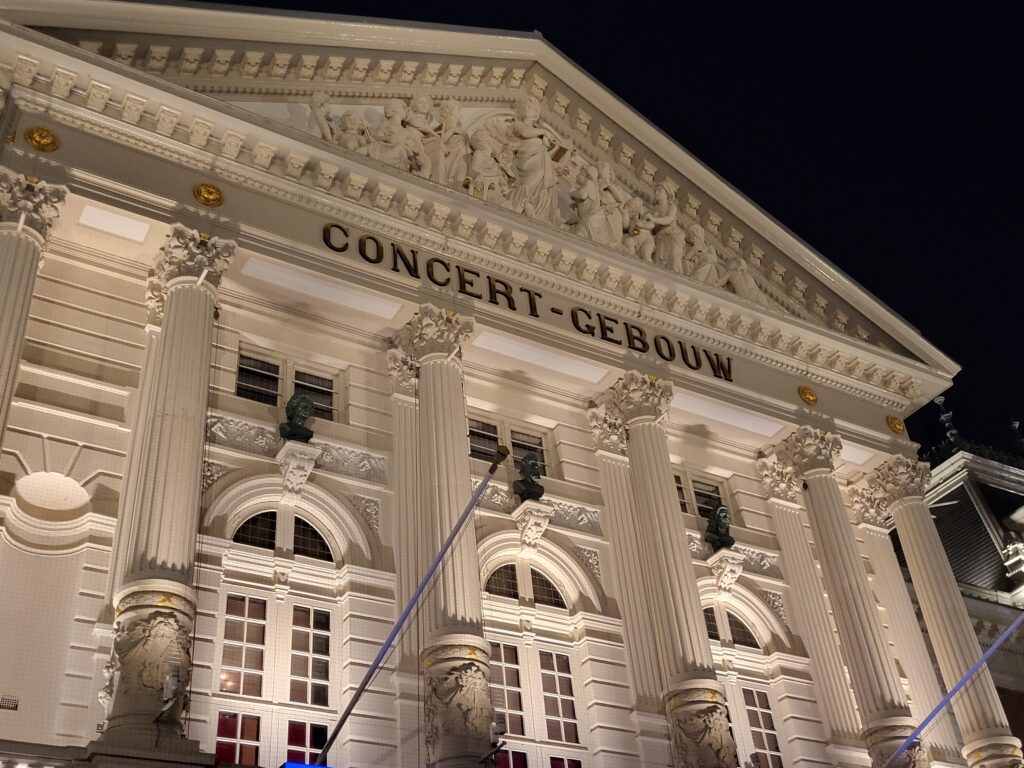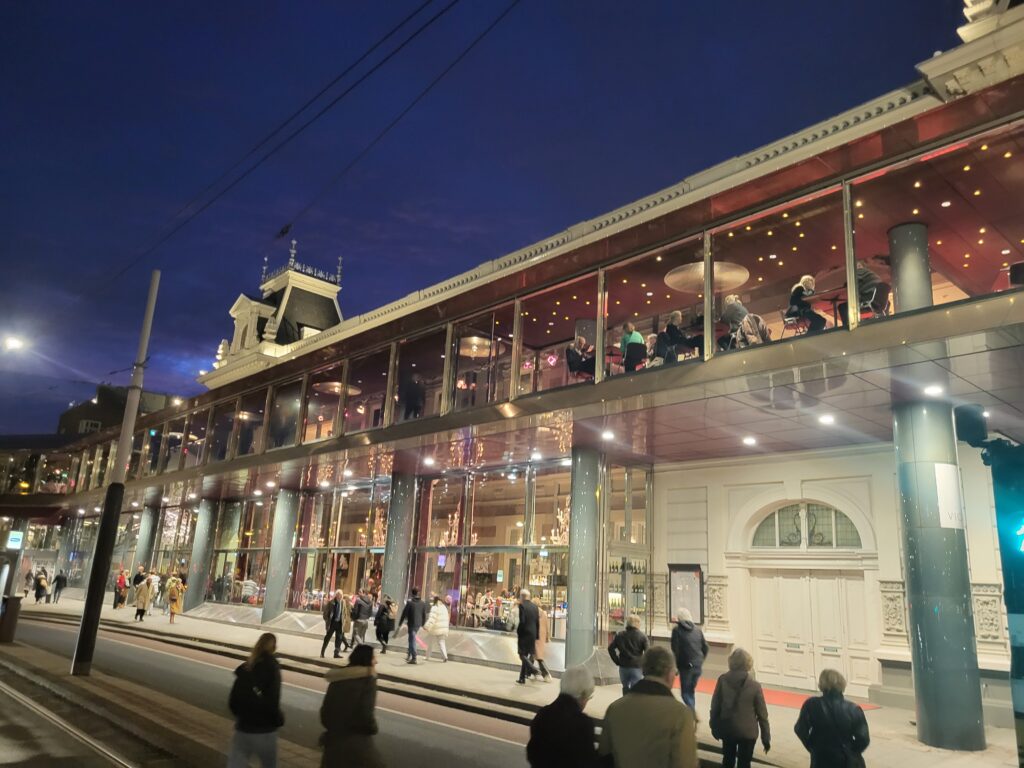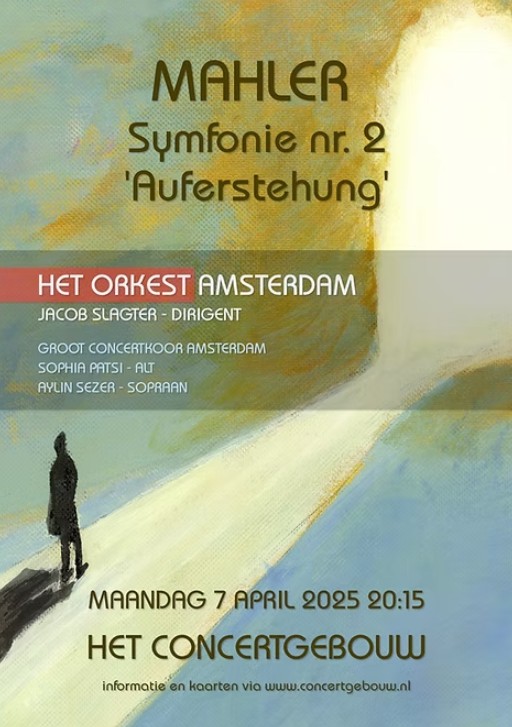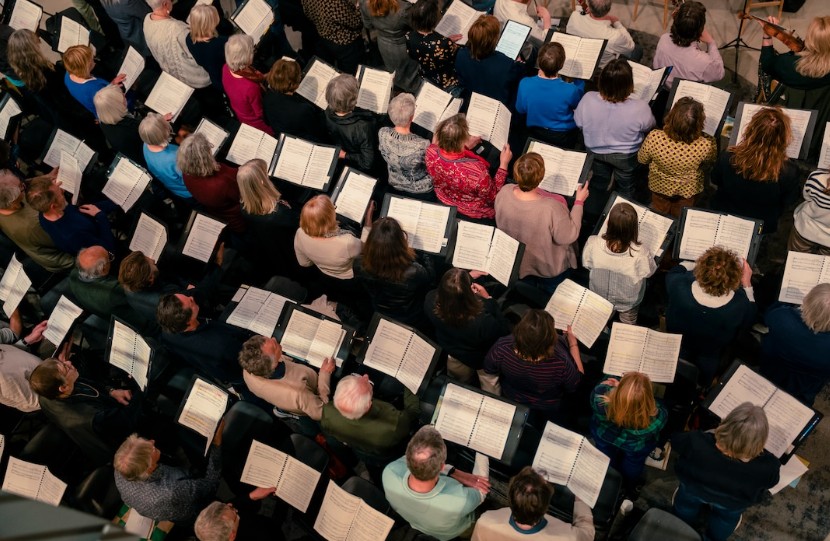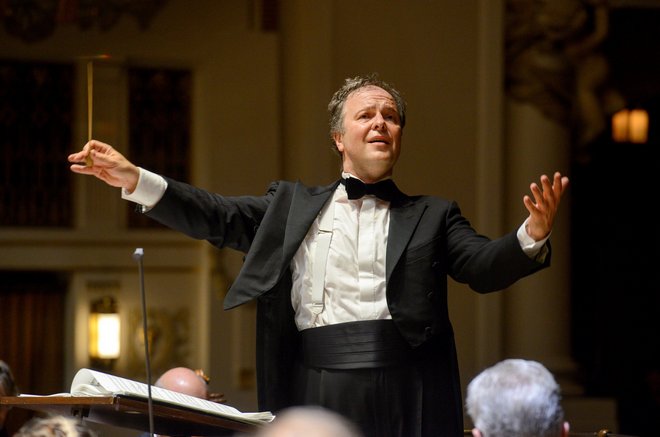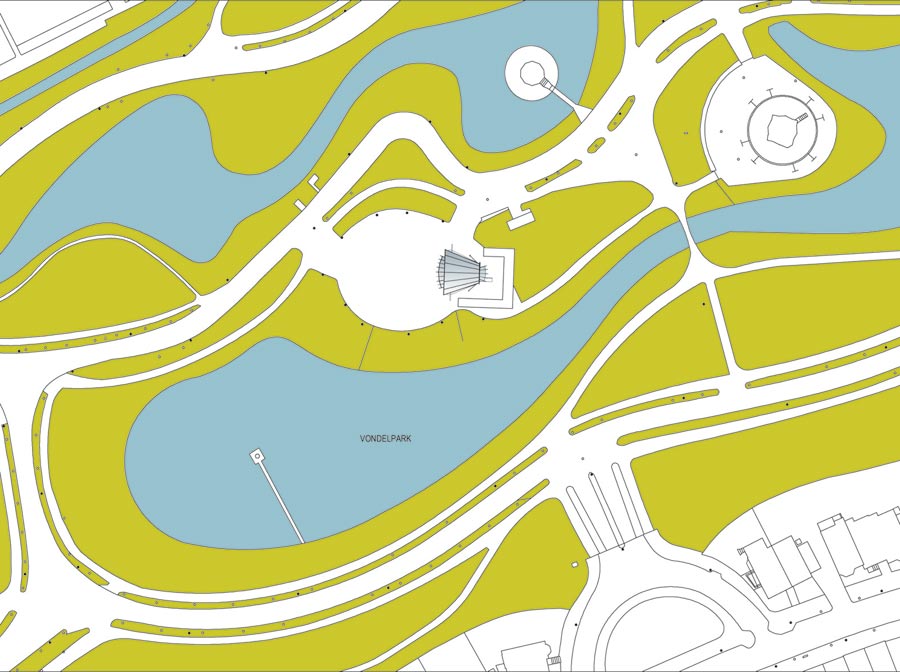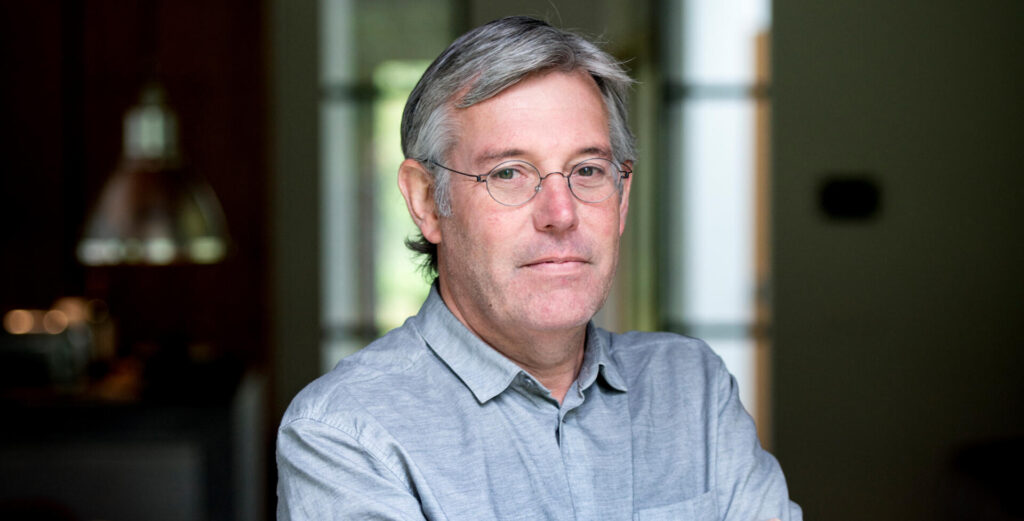Mahler Festival Amsterdam 2025 Blog
01-01-2025 Happy New Mahler Year!
New Year’s Eve party on the Museumplein (Museum Square). Amsterdam celebrates its 750th anniversary this year. The images were taken from the side of the Concertgebouw in the direction of the Rijksmuseum:
02-01-2025 Mahler Again and Finally
Translation Mahler NRC 02-01-2025:
Mahler Again and Finally
A Mahler Festival? Yes and no. Yes, because the first Mahler Festival was in 1920, the second in 1995 and the third actually in 2020. But corona. In May 2020 will be made up for: all of Mahler’s symphonies, with a rich side programme. In 2020, in addition to the Concertgebouw Orchestra, the New York Philharmonic, the Wiener Philharmoniker and the Berliner Philharmoniker would come to do parts of the programme. Absolute top orchestras that Mahler himself conducted. Now the programme with the Budapest Festival Orchestra, the NHK Symphony Orchestra and the Chicago Symphony Orchestra is a little less exciting, although the music remains of course just as great. Fortunately, the Berliner Philharmoniker will come for the Ninth and Tenth Symphonies, and Das Lied von der Erde. In 2020, the concerts would be shown for free on a large screen on the Museumplein. The Concertgebouw cannot yet say whether that will happen this year.
22-01-2025 Concertmasters RCO
Associate 1st concertmaster Tjeerd Top leaves the Royal Concertgebouw Orchestra (RCO) and becomes 1st concertmaster at the Rotterdam Philharmonic Orchestra.
Concertmasters at the RCO are now:
- 1st Concertmaster: Vesko Eschkenazy
- Associate 1st Concertmaster: Ursula Schoch
- Associate 1st Concertmaster: Marijn Mijnders
06-02-2025 Completion of the Bruckner cycle
The Concertgebouw Orchestra rounds off the symphonic cycle marking Anton Bruckner’s 200th birthday with his enigmatic swansong, the Symphony No. 9 – including the finale, which the latest scholarship has deemed complete.
In Bruckner’s greatest, elusive “Ninth Symphony”, conductor Honeck lets details shine. Bruckner’s Ninth without reconstruction is purifying enough (Volkskrant 10-02-2025)
15-02-2025 Teaser Concertgebouw and Royal Concertgebouw Orchestra (RCO)
Gustav Mahler – Symphony No. 2 (Brass Choral), Royal Concertgebouw Orchestra (RCO) in the Concertgebouw, Amsterdam, the Netherlands. Conductor Daniele Gatti.
15-02-2025 AVROTROS Radio playlist HD recordings
AVROTROS will broadcast some of the concerts on NPO 2. All concerts can be heard and seen live on NPO 2 Extra. NPO Klassiek will also broadcast (some of) the concerts. The AVROTROS Sunday Morning Concert will tie in with two concerts during the festival that can be visited and sounded live on NPO Klassiek. On Sunday 11 May, the young Chianti Ensemble will play Mahler’s piano quartet and on Sunday 18 May, pianist Thomas Beijer will perform an arrangement for piano solo from the Fourth Symphony.
- AVROTROS Mahler HD Concerts playlist
- AVROTROS Mahler Festival page
- NPO Klassiek Homepage (live stream)


18-02-2025 Order the Mahler Festival Book now
On the occasion of the Mahler Festival 2025, the Mahler Festival Book, Mahler’s Universe, will be published. The 116-page, richly illustrated book, in hardcover, is a must-have for every festival visitor and Mahler lover and can be ordered now!
The Mahler Festival Book includes:
- Articles by Jan Brokken, Michel Khalifa, Geert Mak and Vrouwkje Tuinman.
- Interviews with conductors Klaus Mäkelä, Jaap van Zweden and Iván Fischer, Marina Mahler (the composer’s granddaughter), pianist Julius Drake and singers Fleur Barron and Axelle Fanyo.
- Background information about the symphonies and songs.
- Concert programmes and biographies of the performers.
Would you like to be assured of a copy? Then order the book now! You can have the book sent to you, so that you have it at home about a week before the start of the Festival, or you can pick it up at your first concert. The book costs €29.95 regardless of whether you choose home delivery or pick up.
- Festival Book English edition
- Festivalboek Nederlandse editie
Please note: we can only send books to addresses in the Netherlands.
22-02-2025 Mahler Talk: Pre-concert talks (English spoken)
Before each symphony there will be introductory talks, presented by Morten Solvik. Morten Solvik is a musicologist and an international educator active in presenting music and culture to audiences through his writings in various publications, talks at conferences and concerts, and appearances in documentaries. He is the producer and host of the monthly livestream The Mahler Hour, the Artistic Director of the Gustav Mahler Festival in Steinbach am Attersee, and board member of a number of Mahler-related organizations, including Mahler Foundation. Solvik resides in Vienna, Austria where he serves as Dean of Central Europe (Vienna, Berlin, Freiburg) for IES Abroad, a study abroad provider with centers worldwide.
24-02-2025 Mahler around the World
Mahler Foundation organizes a meeting for all represented Mahler societies. Details follow.
25-02-2025 Museumplein Live
During the evening concerts, all symphonies will also be broadcast live from the Large Hall on a large screen on the Museumplein (Museum Square). Everyone is welcome to join in, with shelter from the elements; admission is free.
27-02-2025 Additional program
- Introductions and discussions.
- Mahler tour of the neighbourhood by Herman Rieken (percussionist of the Concertgebouw Orchestra)
- Mini-exhibition.
- Lecture in the Rijksmuseum.
- Screening of Mahler documentaries in the EYE Film museum.
02-03-2025 Concertzender (Concert radio channel)
The Concertzender will also pay attention to Mahler in May in the program In the spotlight. Program maker Emanuel Overbeeke will discuss historical recordings.
11-03-2025 Mahler Talk (English spoken)
Before the concerts there will be Mahlers Talks by Morten Solvik, providing an in depth introduction to the symphonies, of the international Mahler Foundation.
11-03-2025 Mahler Late Night (Concertgebouw Recital Hall, English spoken)
After various concerts visitors can continue their evening at Mahler Late Night, an after talk in the Recital Hall with conductors and musicians of various orchestras in the recital hall.
Need to let your Mahler experience sink in? You can do so during Mahler Late Night in the Recital Hall. After the concert, writer and musicologist Vrouwkje Tuinman will talk with the conductor, a member of the orchestra or another guest. In an informal setting they reflect on tonight’s concert. These conversations are in English.
11-03-2025 Photos and buste (Concertgebouw)
In the foyers and hallways The Concertgebouw presents photos of Mahler visiting the Netherlands. And of course visitors can see the is the famous buste of Mahler that is on permanent display at The Concertgebouw. This buste was made by his daughter Anna, and offered by her daughter Marina at the Mahler Festival in 1995 to The Concertgebouw.
11-03-2025 Live screen, broadcast and Mahlers Universe (Mahler pavilion)
The Mahler Festival in Amsterdam can be followed free of charge from 8 to 18 May during the Mahler Nights on Museumplein (Museum Square). Each evening, 2,000 visitors can enjoy live broadcasts of the concerts on a 10-meter-wide LED screen, complemented by an immersive audio system. The broadcasts of each symphony is preceded by an episode of the documentary series Mahlers Universe, created for The Concertgebouw and the International Mahler Foundation. All symphonies will also be broadcasted in the Netherlands by the Dutch public broadcaster AVROTROS via television, radio and streaming.
Update 18-04-2025: Mahler Night moved to Vondelpark theater (Mahler pavilion)
11-03-2025 Manuscript Symphony No. 7 (Rijksmuseum)
The Rijksmuseum will present a special exhibition related to Mahler, featuring the original Manuscript of the Seventh symphony (a gift of Alma Mahler to The Concertgebouw at the 1920 Mahler Festival) and never-displayed photos from the personal archive of Alphons Diepenbrock, a personal friend of Gustav Mahler.
11-03-2025 Mahler plays Mahler (11-05-2025 in Rijksmuseum). Plus presentation.
The Rijksmuseum will also host the concert Mahlers plays Mahler. In 1905 Mahler briefly took his seat behind the piano in the factory of M. Welte & Sohn in Leipzig so that his playing could be recorded on piano rolls. In this way, Mahler’s own renditions of two songs and excerpts from the Fourth and Fifth symphonies have been preserved. Alongside this you will hear the composer as an accompanist in a number of songs, sung by soprano Jeannette van Schaik. The curators of Pianola Museum and the Rijksmuseum music department will provide an introduction.
Program
Mahler – Trauermarsch: In gemessenem Schritt. Streng. Wie ein Kondukt (uit ‘Symfonie nr. 5 in cis’)
Mahler – Ging heut’ morgen übers Feld (uit ‘Lieder eines fahrenden Gesellen’)
Mahler – Ich ging mit Lust durch einen grünen Wald, nr. 7 (uit ‘Lieder und Gesänge’)
Mahler – Das himmlische Leben
Diepenbrock – Die Liebende schreibt
Diepenbrock – Lied der Spinnerin
Mengelberg – Der Ungenannten
Mengelberg – Komm’ über das Meer
Performers
Pianola: Gustav Mahler
Soprano: Jeannette van Schaik
Piano: Peter Nilsson
Curator of the pianola museum/speaker: Kasper Janse
Curator Rijksmuseum/moderator: Giovanni Di Stefano
During the Mahler Festival, the Rijksmuseum will also be showing a small presentation with scores and photographic material of Mahler and his good friend Diepenbrock.
11-03-2025 Conducting Mahler (EYE Filmmuseum)
The EYE Filmmuseum will feature screenings of various documentaries exploring the composer’s life and work. Among other films by Frank Scheffer the museum presents “Conducting Mahler” featuring interviews with the conductors of the Mahler Festival in 1995: Bernard Haitink, Riccardo Chailly, Claudio Abbado, Ricardo Mutti en Simon Rattle.
- Interviews: Donald Mitchell
- Director: Frank Scheffer
- Runtime: 1 hour 15 minutes
11-03-2025 Mahler Walks (Concertgebouw)
Mahler aficionados can also experience Mahler Walks through the Concertgebouw neighborhood, tracing the composer’s footsteps together with Concertgebouworkest percussionist Herman Rieken. He will share his own experiences with the Concertgebouworkest playing Mahler and he will show the places Mahler visited during his stays in Amsterdam.
11-03-2025 Symphonic Cinema (Theatre Amsterdam)
Theatre Amsterdam will host Symphonic Cinema concerts. Film maker Lucas van Woerkum created silent films on the soundtrack of classical music. In The Echo of Being, he interweaves movements from Mahler’s Second, Fourth, Eighth, Ninth and Tenth Symphony with a cinematic story about Gustav and Alma Mahler and their daughter Maria. Leading roles are played by Amira Casar (Call Me by Your Name) and Greg Wise (The Crown).
Filmmaker Lucas van Woerkum creates silent films inspired by classical music. In The Echo of Being he interweaves parts of Mahler’s Second, Fourth, Eighth, Ninth and Tenth Symphonies with a cinematic story about Gustav and Alma Mahler and their daughter Maria. Leading roles are reserved for Amira Casar (Call Me by Your Name) and Greg Wise (The Crown). The music is orchestrated by composer Thomas Beijer and is played live by the New European Ensemble. Van Woerkum synchronizes the film live from the stage, creating a unique symbiosis between music and image.
The film explores the dying process of daughter Maria through the eyes of the three family members. Their pain and loss, but especially their love for nature, life and the unknown, are central. The journey to the afterlife, seen by the dying daughter, is visualized with fractal animations based on the musical structure.
18-03-2024 Live Radio and Live TV (Concertgebouw)
Live Radio
The following “NPO Klassiek – Radio4” radioprogrammes will report live from the festival: “De Klassieken”, “Een goedemorgen met” and “Opium”.
- De Klassieken | NPO Klassiek (The Classics)
- Een goedemorgen met… | NPO Klassiek (A good morning with…)
- Opium | NPO Klassiek
Live TV
All evening concerts can be viewed live on: “NPO Klassiek” and on “NPO2 Extra”. Presenter is Maria Fiselier. Mezzo-soprano Maria Fiselier is the new presenter of AvroTros. From now on she will present all TV recordings of classical concerts and events at the broadcaster.
20-03-2025 Hell Mountain - a Mahler homage for orchestra
The work that Anders Hillborg composed on behalf of the Concertgebouw Orchestra, the Orchestre de Paris and Mahler Foundation is called “Hell Mountain”. Premiere at the Mahler Festival 09-05-2025.
Hell Mountain – a Mahler homage for orchestra
- Composed: 2024.
- Length: 22′.
- Instrumentation: 3 flutes (all = piccolos) 3 oboes 3 clarinets in Bb soprano saxophone in Bb 2 bassoons contrabassoon 4 horns in F 3 trumpets in C 2 tenor trombones bass trombone contrabass trombone tuba timpani percussion (3 players): I: tubular bells II: glockenspiel tam-tam III: crotales bass drum harp piano strings.
- Dedicated to Klaus Mäkelä.
22-03-2025 Mahler Hour Live! - Mahler Award (17-05-2025)
Meeting and broadcast: 17-05-2025
Concert featuring a world premiere by Sebastian Black, presentation of the Mahler Award, interviews with Marina Mahler, the composer’s granddaughter, Simon Reinink, Director of the Concertgebouw and more!
- Mahler Foundation (Website)
- Mahler Foundation (YouTube)
- Mahler Foundation – Hour Hour (YouTube)
22-03-2025 Mahler Vote
Vote for your favorite composition by Gustav Mahler:
24-03-2025 Dear Mahler! (08-05-2025)
Who was Mahler? Who is Mahler? What does Mahler’s music sound like? What makes his music special? And what have Mahler and his music done to us? In Dear Mahler! we search for answers to these questions. With conductor Lorenzo Viotti, baritone Florian Boesch, the Netherlands Philharmonic Orchestra and various people who each had their own connection with Mahler, we travel through Mahler’s impressive oeuvre on the basis of personal letters – full of memories, reflections and critical notes.
A journey like Mahler’s work itself: compelling, moving, funny, tragic, with jubilant joy and deep sorrow. Packed with the most beautiful and best pieces from Mahler’s oeuvre. Dear Mahler! is for everyone who wants to get to know the great work of the composer Gustav Mahler. And for anyone who already knows Mahler’s music but wants to immerse themselves in his work and life in a different way.
Netherlands Philharmonic
Conductor: Lorenzo Viotti
Baritone: Florian Boesch
Actor: Charlie Chan Dagelet
Actor: Bram Suijker
28-03-2025 Mäkelä and Seung-Won Oh in Amsterdam
Spectacular music by Seung-Won Oh (Spiri III: Sacred), the Royal Concertgebouw Orchestra and Klaus Mäkelä. The composer (1969) is present in the hall and receives congratulations on stage afterwards. A world premiere, commissioned composition with financial support from the Performing Arts Fund. The Offertorium (violin concerto) by Sofia Goebaidoelina (1931-2025) was also performed. Violinist Julian Rachlin.
No signs of the upcoming Mahler Festival yet.
01-04-2025 MAHLER! podcast The symphonies (40 episodes, Dutch)
Mahler! The symphonies. Gijs Groenteman (journalist), Thomas Oliemans (singer) and Thomas de Jonker (musicologist) meticulously examine Mahler’s 9 completed symphonies. Part by part, for 20 hours. With exhaustive attention to the notes and to Mahler’s biography. 40 episodes. See also the live podcast Das Lied von der Erde at 07-05-2025.
Link to MAHLER! podcast (opens in new tab)
03-04-2025 Tickets for Mahler Talk and Mahler Late Night
The tickets are free for concert visitors. Distribution of the tickets starts today with the owners of a passe-partout.
Mahler Talk (Recital Hall)
- 09-05-2025 19:00 Tickets (Choir Hall)
- 10-05-2025 19:00 Tickets
- 11-05-2025 19:00 Tickets
- 12-05-2025 19:00 Tickets
- 13-05-2025 19:00 Tickets
- 14-05-2025 19:00 Tickets
- 15-05-2025 19:00 Tickets
- 16-05-2025 19:00 (Main Hall, no tickets needed)
- 17-05-2025 19:00 Tickets
- 18-05-2025 19:00 Tickets
Mahler Late Night (Recital Hall)
- 09-05-2025 22:15 Tickets
- 10-05-2025 22:00 Tickets
- 11-05-2025 No
- 12-05-2025 22:00 Tickets
- 13-05-2025 No
- 14-05-2025 21:50 Tickets
- 15-05-2025 No
- 16-05-2025 22:15 (Main Hall, no tickets needed)
- 17-05-2025 No
- 18-05-2025 No
01-04-2025 Photo album
Photo album Mahler Festival Amsterdam 2025 is live.
07-04-2025 Het Orkest and the Grand Concert Choir Amsterdam
Amateur orchestra Het Orkest Amsterdam and amateur Grand Concert Choir Amsterdam play Gustav Mahler Symphony No. 2 in the Main Hall of the Concertgebouw. Conductor is Jacob Slagter (1958). He was principal hornist of the Royal Concertgebouw Orchestra from 1985 to 2008. Concert Sold out.
The Orchestra Amsterdam is an amateur symphony orchestra that was founded forty years ago and has been working towards a concert three times a year ever since. The orchestra started rehearsing last winter, together with the Groot Concertkoor Amsterdam.
In order to be able to play the symphony, both the choir and the orchestra had to look for more than eighty extra musicians. About thirty-five male voices, almost eleven percussionists and a whole bunch of brass players. That line-up was found surprisingly quickly. ‘Most orchestra members have musical friends in their network from other orchestras or from the past’, says Kerr. ‘And people like to participate in a project if they get the chance to play in the Concertgebouw.’ Auditioning was not necessary, playing along to a few rehearsals was enough. ‘We think our members have a good enough idea of the level that people have.’
08-04-2025 St. Matthew Passion
The St. Matthew Passion by Johann Sebastian Bach has become a deeply rooted Easter tradition in the Netherlands, especially since the early twentieth century. A key figure in this development was Willem Mengelberg, conductor of the Concertgebouw Orchestra, who introduced annual performances of the Passion in 1899. Since then, it has grown into a cherished event for many Dutch people.
The work will be carried out in many places in the Netherlands over the next two weeks. St. Matthew Passion (video).
09-04-2025 Rembrandt in H'Art museum (until 24-08-2025)
A special exhibition in the H’Art museum in Amsterdam: 75 works by Rembrandt, Vermeer and Frans Hals. They are owned by a rich American (Thomas Kaplan), who now wants to show the paintings in Amsterdam, because the city exists 750 years.
14-04-2025 Friend of the Concertgebouw and Concertgebouworchestra
By becoming a Friend you support The Concertgebouw and the Concertgebouworkest, as well as a range of projects that introduce a young and diverse audience to classical music in inspiring and exciting ways.
- Access to private rehearsals and discounts on recordings and books.
- A stand is located in the cloakroom of the building.
- Concertvrienden website
16-04-2024 Mahler Foundation event: 17-05-2025
Recital Hall: Mahler Foundation Event
For people from different Mahler Societies around the world
Expected 17-05-2025, 16:00
Details to follow
17-04-2025 Sakari Oramo will replace Daniel Barenboim on 18-05-2025
- Due to health reasons, conductor Daniel Barenboim (1942) has had to cancel his concert in Amsterdam on 18 May during the Mahler Festival, much to his regret.
- The Berliner Philharmoniker is very grateful that conductor Sakari Oramo (1965) is prepared to take over the programme unchanged. Oramo is chief conductor of the BBC Symphony Orchestra and artistic partner of the Gürzenich-Orchester Köln. Since 2001, he has regularly been a guest conductor for the Berliner Philharmoniker.
17-04-2025 Mahler live in theaters throughout the Netherlands (09-05-2025)
For the first time, a symphonic concert can be followed live from Het Concertgebouw in nine cinemas. On Friday evening, 9 May, the Mahler Festival opens with Gustav Mahler’s First Symphony, performed by the Royal Concertgebouw Orchestra conducted by Klaus Mäkelä. This special concert can be experienced live that evening in nine Pathé theatres spread throughout the Netherlands, from Maastricht to Groningen. In this way, Het Concertgebouw and the Concertgebouw Orchestra want to give even more audiences the opportunity to experience this sold-out concert live. In Pathé Buitenhof (Den Haag), Delft, Groningen, Maastricht, Nijmegen, Schouwburgplein (Rotterdam), Tilburg Centrum, Leidsche Rijn (Utrecht) and Zwolle.
18-04-2025 Mahler Nights moves to Vondelpark theatre
The Mahler Nights, where the Mahler Festival evening concert in Het Concertgebouw can be followed for free on a large screen every day from 8 to 18 May, will be moved from Museumplein to Vondelpark Open Air Theatre due to a possible tribute to Ajax. Concerts are held in the Vondelpark Open Air Theatre every summer, but never before have live broadcasts of concerts from Het Concertgebouw been shown. For the occasion, the Vondelpark Open Air Theatre will be converted and covered. This will create the most beautiful music cinema in Amsterdam, with images and sound of the highest quality. There will be room for 1,500 spectators per evening. There is a beautiful link between Gustav Mahler and Vondelpark. During Mahler’s visits to Amsterdam, he always stayed with conductor Willem Mengelberg on Van Eeghenstraat 105 and 107; with a view of Vondelpark. This completes the circle.
22-04-2025 Singing Mahler Yourself
Sing and Experience Mahler. On the evenings of 22-04-2025, 29-04-2025 and 06-05-2025 there will be workshops in the Concertgebouw in the Choir Hall where the choir parts of Symphony 2, 3 and 8 will be reviewed and you can sing them yourself under the direction of Hans Veldhuizen. No singing experience is necessary. You can register at the Concertgebouw.
24-04-2025 Mahler Merchandise
Specially for the Mahler Festival, unique merchandise has been developed. The unique pins, postcards, chocolates, bags, wine glasses and the official festival book can be purchased during the festival in Het Concertgebouw.

24-04-2025 Rijksmuseum: Small presentation Mahler documents
During the Mahler Festival, the Rijksmuseum will also be showing a small presentation with scores and photo material of Mahler and his good friend Diepenbrock. The language of instruction is English. Tickets are name-bound (linked to a museum ticket or museum card), so you can only purchase 1 ticket per order.
26-04-2025 Mahler Hour Live! - Special: Gustav Mahler and the Netherlands
Podcast by Mahler Foundation with special guest Eveline Nikkels (chair of the Gustav Mahler Foundation Netherlands) about Gustav Mahler in the Netherlands and the upcoming festival. Host: Morten Solvik.
- Mahler Foundation (Website)
- Mahler Foundation (YouTube)
- Mahler Foundation – Hour Hour (YouTube)
27-04-2025 Ceremony Ajax (Museumplein)
Football team Ajax from Amsterdam can become Dutch Champion season 2024/2025 on the following match days:
- 11-05-2025 Sunday 16:45-18:30 match Ajax-NEC (Festival day 3)
- 14-05-2025 Wednesday 20:00-21:45 match Groningen-Ajax (Festival day 6)
- 18-05-2025 Sunday 14:30-16:15 match Ajax-Twente (Festival day 10)
Crowds are expected at Museumplein, Leidseplein and around the Amsterdam Arena. A ceremony will probably take place at the Museumplein. Depending on the progress of the competition, the ceremony may take place earlier. Winning the title gives Ajax the right to participate in the Champions League the following season.
Update 18-04-2025: This possible conjunction has been prevented by moving the Mahler Nights from the Museumplein to the Vondelpark theatre.
01-05-2025 Gustav Mahler in the Jordaan (Mahler tour)
Mahler in the Jordaan on May 1, 2025 as a prelude to the Mahler Festival
We cannot be certain whether Mahler ever visited the Jordaan, but it cannot be ruled out that he also visited the Westerkerk on his walks through Amsterdam, so for our first Mahler Day of 2025 on May 1, we will make a trip to a location that is posthumously very closely associated with Mahler, the Pianola Museum. This museum contains two Mahler specialities. Firstly, the Welte Mignon Vorsetzer, on which Mahler – literally – personally presents us with some compositions, including the first part of the Fifth Symphony and Das himmlische Leben from the Fourth Symphony. In addition, this museum also has a Mahler Four on a pianola roll, so a nice comparison is possible here.
We have the museum to ourselves that morning. And that is why a lecture by Herman Krieken, percussionist of the Royal Concertgebouw Orchestra (RCO), can also take place there. He will take us to the use of percussion in Mahler’s symphonies, and given his knowledge and passionate way of telling, it will be very special. And we can ask him questions along the way, he just likes that!
You may have noticed that we are going to ‘Mahleren’ on a special day. Mahler once walked in the May 1st parade in Vienna and so we are walking in the footsteps of our Gustav in the Jordaan.
You can register with Frank Hagemans via f.hagemans@gmail.com
Gustav Mahler Stichting Nederland (GMSN)
01-05-2025 Special Mahler Edition Preludium.
Preludium has been the name of the magazine since 1947, in which stories and concert programmes serve as a kind of ‘preparation’ for the music in the Concertgebouw. In the 05-2025 special edition attention is paid to Alma Mahler and the Mahler Festival 1995. Furthermore, an analysis is included of the various performances of Symphony No. 3 by the RCO. There is also information about the meeting between Sigmund Freud and Gustav Mahler in Leiden. Amsterdam to Leiden is about 50 km.
02-05-2025 Family concert: The Wunderhorn (Recital Hall)
A brand-new family concert for young and old from 5 years old in the context of the Mahler Festival! The Wonderhorn is a participatory concert in which we bring the fairytale world of Mahler to life together. To give you an idea: a piano stands alone in space. From the belly you hear softly crackling music coming… You press a key and the air fills with something that is nothing yet but could become anything. Then you press a second key… Beautiful! A third key. No, that doesn’t sound good. Maybe… this one? And before you know it, you are floating in a wonderful world between ever and never, right through beautiful stories with special surprises. When you then see an arm dancing out of the piano or a colorful tree growing, you know for sure: in your head, exactly in the middle between your left and right ear: EVERYTHING is possible!
Reprise on 03-05-2025.
06-05-2025 Damiaan Denys & Camerata RCO - Mahler & Freud
“Sharp thinkers”: Stories and music that make you think. Today with philosopher and psychiatrist Damiaan Denys and Camerata RCO. What was the relationship between Gustav Mahler and Sigmund Freud, who took a walk together in Leiden at the beginning of the last century?
Recital Hall, 20:15-21:30. Dutch spoken.
Music:
- Mahler: Piano quartet in a.
- Schreker: Der Wind.
- Mahler: Adagietto.
- Korngold: Suite, op. 23, Groteske.
07-05-2025: MAHLER! Live podcast Das Lied von der Erde and Symphony No. 10 (1 episode, Dutch)
Gijs Groenteman, Thomas Oliemans and Thomas de Jonker examine Mahler’s Das Lied von der Erde. With exhaustive attention to the notes and to Mahler’s biography. Special Mahler Festival episode. Podcast live. Live podcast from the Choir Hall (Koorzaal). See also The symphonies at 01-04-2025.
Link to live podcast (opens in new tab)
17-05-2025 Beyond Mahler (Mahler Foundation)
16:00 Recital Hall:
- Sebastian Black – The Mosaique of the Aire (world premiere, commissioned by Mahler Foundation)
- Gustav Mahler – Symphony No. 4 in G Major (arr. J. Warner)
- New European Ensemble
- Conductor: John Warner
- Soprano: Keren Motseri
The Mahler Foundation is organising a special concert during the Mahler Festival. A concert in which Mahler’s Fourth Symphony and new work by Sebastian Black echo the Mahler Foundation’s core themes of youth, nature and modernity. Themes that were important to the composer Mahler and are more important today than ever. Marina Mahler set herself the task of keeping her Mahler Foundation’s work of her grandfather Gustav relevant; this concert is a pithy example of that.
Two young talents take centre stage this afternoon: conductor John Warner and composer Sebastian Black. Warner leads the New European Ensemble in his own new arrangement for chamber orchestra of Mahler’s Fourth Symphony. In this new version, Warner puts the focus on the orchestra’s personal, individual voices. The result is intimate, beautiful, and totally contemporary. Sebastian Black composed The Mosaique of the Aire, commissioned by the Mahler Foundation. In this work, Black looks at Mahlerian themes of love, nature, youth and peace through the stark glasses of the chaotic present.
Opening Mahler Festival Amsterdam 2025 (Program)
Program / Programma
08-05-2025 Prelude (Thursday)
15:00 Hotel: Check in
16:45 Concertgebouw: Meeting
17:15 Restaurant: Dinner
20:00 Vondelpark theatre/Mahler Pavilion: Mahler Night (outdoor/free)
20:15 Main Hall:
- Dear Mahler!
- Netherlands Philharmonic Orchestra
- Conductor: Lorenzo Viotti
- Baritone: Florian Boesch
- Actors: Charlie Chan Dagelet and Bram Suijker
23:00 Online: Photo album
09-05-2025 Day 1 (Friday)
13:00 Recital Hall:
- Drei Lieder
- Lieder und Gesänge (vol. 1)
- Lieder eines fahrenden Gesellen
- Rückert-Lieder
- Mezzo-soprano: Catriona Morison
- Baritone: James Newby
- Piano: Julius Drake
19:00 Choir Hall: Mahler Talk
20:00 Vondelpark theatre: Mahler Night
20:15 Main Hall:
- Hillborg – Hell Mountain. New composition by Anders Hillborg (1954). Commissioned by Mahler Foundation and the Royal Concertgebouw Orchestra (RCO).
- Symphony No. 1 in D
- Royal Concertgebouw Orchestra Amsterdam (RCO)
- Conductor: Klaus Mäkelä
22:15 Recital Hall: Mahler Late Night
23:00 Online: Photo album
10-05-2025 Day 2 (Saturday)
13:00 Recital Hall:
- Des Knaben Wunderhorn
- Alto: Ema Nikolovska cancelled. Replaced by Beth Taylor.
- Bass-baritone: Jusung Gabriel Park
- Piano: Julius Drake
13:30 Main Hall:
- Symphony No.1 in D
- Royal Concertgebouw Orchestra Amsterdam (RCO)
- Conductor: Klaus Mäkelä
19:00 Recital Hall: Mahler Talk
20:00 Vondelpark theatre: Mahler Night
20:15 Main Hall:
- Symphony No. 2 in c “Auferstehung”
- Budapest Festival Orchestra
- Soprano: Christiane Karg
- Mezzo-soprano: Anna Lucia Richter
- Choir: Grootomroep
- Conductor: Iván Fischer
21:00 Theatre Amsterdam: Symphonic Cinema The Echo of Being
22:00 Recital Hall: Mahler Late Night
23:00 Online: Photo album
11-05-2025 Day 3 (Sunday)
11:00 Recital Hall:
- Piano Quartet in a minor
- Webern – Langsamer Satz
- Dvořák – Piano Quintet No. 2 in A major, op. 81.
- Chianti Ensemble
11:00 Main Hall
- Symphony No. 2 in c “Auferstehung”
- Budapest Festival Orchestra
- Conductor: Iván Fischer
13:30-13:45 Rijksmuseum entrance
14:00 Rijksmuseum (Auditorium) Mahler Plays Mahler (plus small presentation of documents)
15:30 Mahler Walk
16:00 Eye Film Museum: Conducting Mahler
19:00 Recital Hall: Mahler Talk
20:00 Vondelpark theatre: Mahler Night
20:15 Main Hall:
- Symphony No. 3 in d
- NHK Symphony Orchestra
- Mezzo-soprano: Olesya Petrova
- Choir: Grootomroep female
- Conductor: Fabio Luisi
23:00 Online: Photo album
12-05-2025 Day 4 (Monday)
16:00 Eye Film Museum: Voyage to Cythera
19:00 Recital Hall: Mahler Talk
20:00 Vondelpark theatre: Mahler Night
20:15 Main Hall:
- Lieder from Des Knaben Wunderhorn
- Symphony No. 4 in G
- NHK Symphony Orchestra
- Soprano: Ying Fang
- Baritone: t.b.a.
- Conductor: Fabio Luisi
22:00 Recital Hall: Mahler Late Night
23:00 Online: Photo album
13-05-2025 Day 5 (Tuesday)
17:00 Main Hall:
- Symphony No. 5 in cis
- Budapest Festival Orchestra
- Conductor: Iván Fischer
19:00 Recital Hall: Mahler Talk
20:00 Vondelpark theatre: Mahler Night
20:15 Main Hall:
- Kindertotenlieder
- Symphony No. 5 in cis
- Budapest Festival Orchestra
- Mezzo-soprano: Anna Lucia Richter
- Conductor: Iván Fischer
23:00 Online: Photo album
14-05-2025 Day 6 (Wednesday)
13:00 Recital Hall:
- Das Lied von der Erde
- Mezzo-soprano: Feride Büyükdenktas
- Tenor: Stuart Jackson
- Piano: Julius Drake
15:30 Concertgebouw (Concertgebouwplein, revolving door): Mahler Walk
16:00 Eye Filmmuseum: Gozaran
19:00 Recital Hall: Mahler Talk
20:00 Vondelpark theatre: Mahler Night
20:15 Main Hall:
- Symphony No. 6 in a “Tragische”
- Chicago Symphony Orchestra
- Conductor: Jaap van Zweden
21:50 Recital Hall: Mahler Late Night
23:00 Online: Photo album
15-05-2025 Day 7 (Thursday)
13:00 Recital Hall:
- Songs from ‘Des Knaben Wunderhorn’
- Lieder und Gesänge (vol. 2 en 3)
- Kindertotenlieder
- Mezzo-soprano: Fleur Barron
- Tenor: Laurence Kilsby
- Piano: Julius Drake
19:00 Recital Hall: Mahler Talk
20:00 Vondelpark theatre: Mahler Night
20:15 Main Hall:
- Symphony No. 7
- Chicago Symphony Orchestra
- Conductor: Jaap van Zweden
23:00 Online: Photo album
16-05-2025 Day 8 (Friday)
15:30 Mahler Walk
16:00 Eye Film Museum: Voyage to Cythera
19:00 Main Hall: Mahler Talk (no tickets needed)
20:00 Vondelpark theatre: Mahler Night
20:15 Main Hall:
- Symphony No. 8 in Es “Symphonie der Tausend”
- Royal Concertgebouw Orchestra Amsterdam (RCO)
- Soloists: t.b.a.
- Choir: Grootomroep choir
- Choir: Laurens Symfonisch choir
- Choir: Le Choeur de l’Orchestre de Paris choir
- Choir: National childrens choir
- Conductor: Klaus Mäkelä
22:15 Main Hall: Mahler Late Night (no tickets needed)
23:00 Online: Photo album
17-05-2025 Day 9 (Saturday)
10:30 Eye Film Museum: Conducting Mahler
13:00 Recital Hall:
- Recital Alma Mahler
- A. (Alma) Mahler – Die stille Stadt
- Zemlinsky – Sie kam zum Schloss gegangen (from ‘Sechs Gesänge’, op. 13)
- A. Mahler – In Meines Vaters Garten (from ‘Seven songs’)
- Berg – Schlafen, schlafen (from ‘Vier Lieder’, op. 2)
- A. Mahler – Laue Sommernacht
- Schönberg – Erwartung (from ‘Vier Lieder’, op. 2)
- A. Mahler – Bei dir ist es traut (from ‘Seven songs’)
- Webern – Dies ist ein Lied für dich allein (from ‘Fünf Lieder aus Der siebente Ring’)
- A. Mahler – Ich wandle unter Blumen
- Pfitzner – Zum Abschied meiner Tochter (from ‘Drei Lieder’, op. 10)
- A. Mahler – Hymne (from ‘Fünf Lieder’)
- Korngold – Gefasster Abschied (from ‘Vier Lieder des Abschieds’, op. 14)
- A. Mahler – Der Erkennende (from ‘Fünf Lieder’)
- Krenek – Während der Trennung
- A. Mahler – Licht in der Nacht (from ‘Vier Lieder’)
- Stravinsky – Un grand sommeil noir (from ‘Deux poèmes de Paul Verlaine’, op. 9)
- A. Mahler – Ekstase (from ‘Fünf Lieder’)
- Soprano: Axelle Fanyo
- Baritone: Raoul Steffani
- Piano: Julius Drake
16:00 Recital Hall: Mahler Beyond (Mahler Foundation event)
- Special edition of The Mahler Hour. Live on YouTube. Host: Morten Solvik. Concert featuring a world premiere by Sebastian Black, presentation of the Mahler Award, interviews with Marina Mahler, the composer’s granddaughter, Simon Reinink (Director of the Concertgebouw) and more! Mahler Hour Live.
- The Mosaique of the Aire – Sebastian Black (world premiere, commissioned by Mahler Foundation)
- New European Ensemble
- Conductor: John Warner
- Symphony No. 4 in G Major (arr. J. Warner)
- New European Ensemble
- Conductor: John Warner
- Soprano: Keren Motseri
19:00 Recital Hall: Mahler Talk
20:00 Vondelpark theatre: Mahler Night
20:15 Main Hall:
- Symphony No. 9 in D
- Berliner Philharmoniker
- Conductor: Kirill Petrenko
23:00 Online: Photo album
18-05-2025 Day 10 (Sunday)
10:30 Eye Film Museum: Gozaran
11:00 Recital Hall: (Live radio broadcast)
- Recital
- Janáček – 1.X.1905 ‘Sonata’
- Mahler – Ruhevoll, poco adagio (from ‘Symphony No. 4 in G’ (orch. T.A. Beijer)
- Zemlinsky – Fantasien über Gedichte von Richard Dehmel
- Brahms – Vier Klavierstücke, op. 119
- Piano: Thomas Beijer
13:30 Main Hall (matinee):
- Symphony No. 8 in Es “Symphonie der Tausend”
- See concert details at Day 8 Friday 16-05-2025.
19:00 Recital Hall: Mahler Talk
20:00 Vondelpark theatre: Mahler Night
20:15 Main Hall:
- Adagio from “Symphony No. 10 in Fis”
- Das Lied von der Erde
- Berliner Philharmoniker
- Conductor: Sakari Orama
23:00 Online: Photo album
Closing Mahler Festival Amsterdam 2025
The art of conducting
Conducting is the art of directing a musical performance, such as an orchestral or choral concert. It has been defined as “the art of directing the simultaneous performance of several players or singers by the use of gesture.” The primary duties of the conductor are to interpret the score in a way that reflects the specific indications in that score, set the tempo, ensure correct entries by ensemble members, and “shape” the phrasing where appropriate. Conductors communicate with their musicians primarily through hand gestures, usually with the aid of a baton, and may use other gestures or signals such as facial expression and eye contact. A conductor usually supplements their direction with verbal instructions to their musicians in rehearsal.
The conductor typically stands on a raised podium with a large music stand for the full score, which contains the musical notation for all the instruments or voices. Since the mid-19th century, most conductors have not played an instrument when conducting, although in earlier periods of classical music history, leading an ensemble while playing an instrument was common. In Baroque music, the group would typically be led by the harpsichordist or first violinist (concertmaster), an approach that in modern times has been revived by several music directors for music from this period. Conducting while playing a piano or synthesizer may also be done with musical theatre pit orchestras. Communication is typically mostly non-verbal during a performance. However, in rehearsals, frequent interruptions allow the conductor to give verbal directions as to how the music should be played or sung.
Conductors act as guides to the orchestras or choirs they conduct. They choose the works to be performed and study their scores, to which they may make certain adjustments (such as in tempo, articulation, phrasing, repetitions of sections), work out their interpretation, and relay their vision to the performers. They may also attend to organizational matters, such as scheduling rehearsals, planning a concert season, hearing auditions and selecting members, and promoting their ensemble in the media. Orchestras, choirs, concert bands, and other sizable musical ensembles, such as big bands are usually led by conductors.
- Mahler Festival Amsterdam 2025 Blog
- Mahler Festival Amsterdam 2025 Program
- Mahler Festival Amsterdam 2025 Photo album
- Private blog by Bert van der Waal van Dijk (the Netherlands)
- Bold font indicates that Bert and Judith van der Waal van Dijk are present
- Mahlerfeest 2025
- Mahler Foundation
- Mahler Festival Start
- Mahler Festival official





